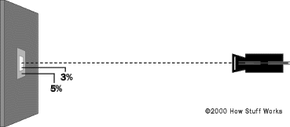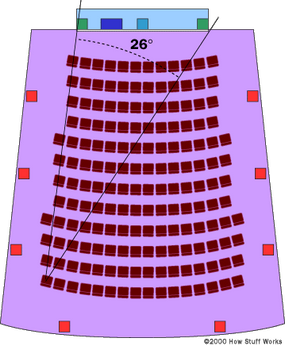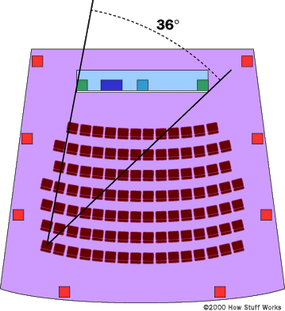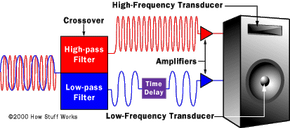Certainly, high-quality sound is at the heart of the THX process. In developing the criteria for THX sound, THX engineers looked at two distinct parts of a sound system:
The A-chain comprises the components that decode the sound from whatever format it is in and process that signal to remove noise. This includes the audio pickup on the projector and the cinema sound processor. Digital sound formats, such as DTS, Dolby Digital and SDDS, and noise-reduction systems, such as Dolby A and Dolby SR, are systems that improve the A-chain.
The B-chain is basically the rest of the sound system (THX crossover, power amplifiers and speakers). The THX engineers realized that no matter how good the sound coming out of the cinema processor was, a weak B-chain sound system could ruin it. To prevent this problem, THX patented a sound system design consisting of a special crossover and components from a list of THX-approved equipment. The engineers at THX subject all of the professional audio equipment on the list to a battery of tests to ensure that it meets the specifications they have established.
The THX crossover is a proprietary sound processor that separates the low and high frequencies to provide cleaner sound over the theater's sound system. Theater owners do not buy the crossover, but instead lease it as part of the THX licensing arrangement. The crossover uses 24-dB-per-octave high-pass and low-pass filters. The filters keep all of the high frequencies from going to the subwoofer (low-pass) and all of the low frequencies from going to the main speakers (high-pass). This page demonstrates a high-pass filter, and this page demonstrates a low-pass filter.
During the 1990s, THX spread to home theater. VHS and DVD movies that bear the well-known logo have gone through the THX Digital Mastering Program. This is a professional services group that works with studios and post-production facilities to ensure that the highest standards are applied for sound, video, compression, and replication. Check out THX.com: Certified Products for a list of manufacturers that offer THX-approved home theater components. Just remember, unless you set up your home theater in a room that meets the same demanding specifications required for theaters, home THX probably won't sound the same as it does at the movies.
For more information on THX and related topics, check out the links on the next page.






